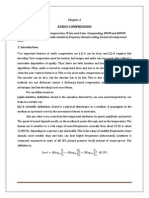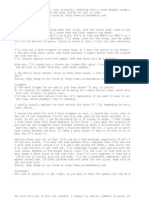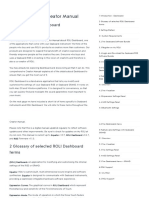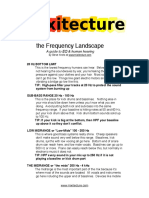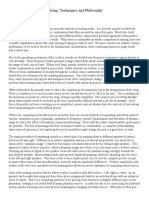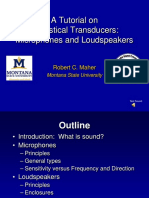Digital Mixing: Page 1 of 3
Digital Mixing: Page 1 of 3
Uploaded by
sheol67198Copyright:
Available Formats
Digital Mixing: Page 1 of 3
Digital Mixing: Page 1 of 3
Uploaded by
sheol67198Original Title
Copyright
Available Formats
Share this document
Did you find this document useful?
Is this content inappropriate?
Copyright:
Available Formats
Digital Mixing: Page 1 of 3
Digital Mixing: Page 1 of 3
Uploaded by
sheol67198Copyright:
Available Formats
intermusic.
com
Page 1 of 3
Digital Mixing
It's increasingly popular for both the home and pro studios
If you take a look through the trade ads these days, you'll notice digital mixers take pride of place over any
analogue desks which happen to be in production. But what has happened to the business of mixing to make
everyone want a digital mixer instead of an analogue one? It wasn't long ago when you could judge a studio's
position in the market by looking at the desk. If it was at least six -foot long with a patchbay the size of a filing
cabinet, it must be a pretty serious studio.
These days, some of the best studios have desks no bigger than a coffee table and home studios often feature
similar desks. Digital mixers have changed the way we work and are changing the way we view the traditional
recording studio.
Total recall
Ten years ago, only desks like the revered SSL had any kind of recall facility. Crude by today's standards, it still
involved putting each and every pot back to the required position yourself, even if the computer did tell you where
that was. Back in the 80s, Yamaha's DMP7 digital mixer offered eight channels of digital mixing with internal
effects and motorised faders for a lot less than most equivalent analogue systems, but it was the early 90s before
things really took off with the Yamaha Pro Mix 01 (or Programmable Mixer 01, as it was later renamed for
copyright reasons). This featured 16 channels with onboard effects, motorised faders and a decent MIDI spec.
Using snapshot memories to recall a mix was suddenly a possibility. At this point, several other manufacturers
entered the market and soon just about every R&D department in the business was working on an affordable
digital mixer.
Over the following years, several models became the main players for the project and pro studio alike, namely the
Yamaha 02R, the Spirit 328 and the Mackie D8B. There are plenty of others, especially in the high-end market,
but these tend to have the size and price of large analogue desks, so they're not really an option for most of us.
The features we've come to expect from digital desks include full EQ on every channel, dynamics on every
channel, internal effects, total recall via snapshots and automation either via a MIDI sequencer or internal. It's a
far cry from a 24-input analogue desk with limited EQ on the monitor section, no effects, no dynamic control and
no recall other than mutes and possibly fader positions, but that's how far we've come. There will always be a
place for analogue desks, but that place is becoming harder to find every day, especially with the prices of the
new breed of digital mixers.
Affordability
When it comes to working in pro studios, the desk you use depends on who booked the studio and what you've
got to record but, for example, for recording strings an analogue Neve desk would be our first choice for its
warmth and good mic amps. Most of the larger studios big enough to record strings are fitted with one. If these
really big studios do have a digital desk, it will usually be the likes of the Euphonix or, on rare occasions, the Sony
Oxford. The kind of desk we're talking about here however, is the kind we can actually afford, like the Spirit 328
and the Mackie D8B.
The 328 and the D8B are very similar. Unlike the Yamaha range and others, they have more of the feel of an
analogue desk. This has earned them many admirers because, being similar to analogue desks, they are more
intuitive to learn.
The one big difference between the two is the Mackie is a lot more expensive. Both are great to record with, both
use 24-bit converters so quality is high and they both have great EQ. The 328 and D8B use rotary encoders with a
segment display that shows the value of a pot. Both use fader switching so you have a different bank of faders at
the press of a switch. This means the desks can perform as tape returns, group sends, even MIDI controllers.
This kind of versatile instant switching is one of the best things about these desks, not forgetting the other big
http://intermusic.com/print.asp?ReviewId=4089&ArticleTable=Features&FeatureType=T... 06/07/2001
intermusic.com
Page 2 of 3
advantage: snapshot store and recall. Restoring all EQ and effects settings on analogue desks involved either
lining up the pots back to where they were on a screen, or pages and pages of written settings for all the outboard
gear. By using more plug-ins and internal effects built into the digital desks, the need for outboard gear is reduced
and switching between songs takes five minutes rather than two hours to get the balance of the mix back. For
songwriting this is a fantastic way to switch between songs rather than having to stay on the one song because
you don't want to change the desk now you have finally got it sounding good.
Professional sound
People sometimes believe they can't get professional results in their home studios because of their desk, but with
these types of digital desks you can. The digital EQ is different and ideally you still need the acoustic environment
of a good studio to achieve a great sound, but it's possible as one of Alan Branch's recent projects proves.
"Recently, I got involved in writing with a band from Leeds called LSK. I used two Spirit 328s linked up, which
gave me a total of 84 inputs, not including the tape returns! We wrote, recorded and mixed loads of tracks in a
little farmhouse using Logic, some plug-ins and the Lexicon effects built into the 328 desks. The album is out now,
has had fantastic reviews and topped the charts in Japan, with singles outselling Madonna!"
You may think it's easy for us to say as engineer/producers, but it is possible to get great results from digital desks
like these. And with the Recall function there is little excuse to keep you from going back to perfect the mix.
Beware of the hype you read about digital desks. We both remember a few articles by certain non -studio working
journalists about how important it is to see the EQ curve and how a mix seemed weird without moving faders
(motors off). This is nonsense. Do you really think professional engineers who mix records every day use a screen
to see the EQ? No, they use their ears.
A screen might actually put your hearing off, as you're using one of your senses to look at the EQ rather than
listening. And as for moving faders, engineers and activists used to joke they were only good for the A&R guy to
look at. But seriously, motorised faders can be useful to see what's going on, but not at the price of not listening to
the mix. A good tip when programming is to look away from the screen when trying to concentrate on a certain
sound, such as checking a crossfade.
How they work
To understand the advantages of a digital mixer, you need to know the principles behind their working methods. In
basic terms, once an audio source enters the desk either via an A/D (analogue to digital) converter or digitally via
one of the many digital formats, everything is done in the digital domain. Zeros and ones are the language of
digital gear and no matter what you do to the signal, all that is really happening is the information is being
modified. Due to this process, no noise, crosstalk, distortion or unwanted degradation of the signal can occur.
Obviously, all this depends on the bit depth of the internal processing and more importantly, the quality of the A/D
and D/A converters. With more and more studios using digital multitracks or DAWs, the connections between the
desk and 'recorder' are often also digital. All this helps keep noise out and sonic integrity to the fore.
As anyone who uses an analogue desk will know, switching between projects is a time-draining and tedious
exercise involving making notes of settings,
chinagraphing channel strips and storing effects settings on all your outboard. I've even seen engineers take
Polaroids of the desk to help assist with resetting the mix later. With snapshot recall, all that is a thing of the past.
Just hit the Store button and name the file. With the press of a button you can recall absolutely everything on the
desk including levels, EQ, effects, compression, gating, expansion, routing and synchronisation settings. As most
project studios revolve around MIDI set-ups, you can easily recall your entire studio's 'status' with a digital mixer
and a SysEx message from your sequencer.
The advantages of recall for a small studio are enormous. You can work on many projects at the same time and
switch between them. If the band you recorded last week wants to come and do a mix half an hour after you finish
another tracking session, you can do it. In a writing studio, if you're recording vocals on one track, then you
suddenly decide you have a great idea for another track you're working on, no problem. It's easy with recall.
Anyone working with sound to picture projects for various clients can instantly recall a mix when they drop in to
see how it's going. It makes life easy when the client wants that snare just a touch louder than when you mixed
the track a week ago and have used the desk for something else since.
Another obvious advantage is price. For under five grand you can get a 40-channel desk with two effects
processors and proper EQ with all the other advantages of digital. Try getting an analogue desk with that spec,
http://intermusic.com/print.asp?ReviewId=4089&ArticleTable=Features&FeatureType=T... 06/07/2001
intermusic.com
Page 3 of 3
then add the cost of all those compressors, gates, effects and an automation system. No chance. With so many
big name producers using these desks for some of the biggest records you've heard lately, there's obviously not a
problem with quality either, so it's almost daft not to go digital.
The last advantage is the size. The footprint of most digital desks is tiny compared to an analogue equivalent. This
means you really can have a pro studio at home. You don't need an enormous desk to get a pro quality sound.
Also, some of these desks are easily portable. Taking them to locations to record or even onstage is not half as
daunting as humping a 40-channel analogue desk up a flight of stairs. Trust us, we've tried it.
And the down side?
It all sounds too good to be true, doesn't it? Well it's not all good news. Digital desks aren't as hands -on as their
analogue forebears. An analogue desk has a button, fader or pot for every single function. There are no menus,
no shared virtual controls and no real difference between operation on any two analogue desks. If you can work
one, you can probably work them all... eventually; it's just a case of finding your way around. Digital desks rarely
have that luxury. They all have different operation systems and often require a lot of 'playing with' before you get
to grips with them. It's not unusual to discover functions you never knew existed on a digital desk, months after
you got it.
Being able to hear something that needs adjusting, then doing it, is pretty much instantaneous on an analogue
desk, but with digital it can take a few button presses before you get there. This might not bother you, but it's the
main stumbling block for many brought up on analogue desks. Then there's maintenance. Digital desks don't
require half as much, but when they go wrong, you really are shafted. It's often a case of back to the
manufacturer. At least with analogue you can work on if a channel goes down or a fader dies.
Last (but certainly not least) there's the sound itself. Analogue desks are often warmer sounding due to their
analogue circuitry. Digital desks, in theory, add no characteristics to the sound whatsoever. A common practice is
to overdrive desk channels for subtle distortion, but with digital it just sounds nasty. This is one of the reasons for
the popularity of valve outboard and channel strips at the moment. You can add that warmth to the signal either
via a mic amp before the signal reaches the desk or via an inserted channel during the mix.
Digital domain
Love it or loathe it, digital mixing is here to stay. The advantages are just too numerous for digital desks not to
catch on, big time. As it is, many home studios are based around HDRs with built-in digital mixers, so the
newcomer to recording is more likely to understand the concepts of a digital mixer than an analogue.
Sean Vincent has seen this first hand: "I remember working with an engineer once who was freaking out because
he had to use a 32-input analogue desk and he'd never used one before. He'd only ever used a Yamaha 02R at
college. All those hands -on controls led him to believe it was going to be a nightmare. The strange thing is, we
had to explain how to use it by comparing the bits of the analogue desk to screens on his digital one. Is it just me,
or is that weird?"
Coming from an analogue background gives you a good insight into signal flow and routing, and we believe that's
where you should start. How else are you going to appreciate the advantages of digital?
The big threat to digital mixers isn't analogue now anyway, it's software. Pro Tools users using something like
ProControl or the Mackie HUI don't need a mixer at all. Even the latest version of Logic has 'live inputs' so you can
feed your audio directly into the mixer within the software. Working this way, you only need to get more analogue
inputs on your soundcard, and systems like the Digi 001 are making this cheaper all the time. The new Control 24
for Pro Tools from Focusrite is another take on the future of mixing, a control surface for the software as well as
analogue inputs for your external gear. The best of both worlds or just a compromise? We'll have to wait and see.
Whatever mixer you choose, make sure you use your ears. Mixing is about music, not technology.
Sean Vincent and Alan Branch
http://intermusic.com/print.asp?ReviewId=4089&ArticleTable=Features&FeatureType=T... 06/07/2001
You might also like
- BOTA CoursesDocument1 pageBOTA Coursessheol6719867% (12)
- PHOTINOS, P. - Musical Sound, Instruments and Equipment PDFDocument168 pagesPHOTINOS, P. - Musical Sound, Instruments and Equipment PDFMiguel LópezNo ratings yet
- Sonarworks Reference 4: User ManualDocument54 pagesSonarworks Reference 4: User ManualDanker Arq100% (1)
- CL and Rio Notes On Setting UpDocument3 pagesCL and Rio Notes On Setting UpAptaeex ExtremaduraNo ratings yet
- Perkins 1100 SeriesDocument48 pagesPerkins 1100 Seriesjrodríguez_658168100% (5)
- Audio Manual for Podcasts: Learn Digital Audio Basics and Improve the Sound of your Podcasts: Stefano Tumiati, #4From EverandAudio Manual for Podcasts: Learn Digital Audio Basics and Improve the Sound of your Podcasts: Stefano Tumiati, #4No ratings yet
- Digital Signal Processing for Audio Applications: Volume 2 - CodeFrom EverandDigital Signal Processing for Audio Applications: Volume 2 - CodeRating: 5 out of 5 stars5/5 (1)
- Home Recording Awesomeness: 6 Mostly Free Tips For Making Your Audio Sound ExpensiveFrom EverandHome Recording Awesomeness: 6 Mostly Free Tips For Making Your Audio Sound ExpensiveNo ratings yet
- Audio Compression Notes (Data Compression)Document35 pagesAudio Compression Notes (Data Compression)infinityankitNo ratings yet
- Intermusic - What The Hell Is MixingDocument4 pagesIntermusic - What The Hell Is MixingvioguitarNo ratings yet
- Intermusic - Eq Masterclass - 2Document7 pagesIntermusic - Eq Masterclass - 2vioguitarNo ratings yet
- Soundbytes Mag: Patch Design For DivaDocument8 pagesSoundbytes Mag: Patch Design For DivaMichael WeinsteinNo ratings yet
- Jands Audio PriceList July 11Document118 pagesJands Audio PriceList July 11Lê Nguyên TríNo ratings yet
- Dios Es La ExistenciaDocument18 pagesDios Es La ExistenciajasonNo ratings yet
- Advancedfx2 ReverbDocument4 pagesAdvancedfx2 Reverbmwalshe1983No ratings yet
- Basslane ManualDocument1 pageBasslane ManualDJ ZOWNKNo ratings yet
- IMPORTANT - Andy Sneap SuggestionsDocument7 pagesIMPORTANT - Andy Sneap SuggestionsSimone Lanzoni100% (1)
- The Art of Sound MixingDocument32 pagesThe Art of Sound MixingJerone RumbaoaNo ratings yet
- Paul White - Recording GuitarDocument3 pagesPaul White - Recording GuitarMauro PriosteNo ratings yet
- Studio Sessions Part 2 - Reverb From PDFDocument4 pagesStudio Sessions Part 2 - Reverb From PDFnishilgeorgeNo ratings yet
- Studio Manual (2014)Document8 pagesStudio Manual (2014)James BatesNo ratings yet
- Audio Recording: SearchDocument10 pagesAudio Recording: Searchnavarro_pauljohn780No ratings yet
- Product Description Michael BentonDocument8 pagesProduct Description Michael Bentonapi-253722555No ratings yet
- Arousor ManualDocument7 pagesArousor ManualOh WowNo ratings yet
- Transformers in The Audio and Sound Industries PDFDocument6 pagesTransformers in The Audio and Sound Industries PDFLogan WolffNo ratings yet
- ROLI Dashboard Creator ManualDocument31 pagesROLI Dashboard Creator ManualBetoNo ratings yet
- Tletronix HistoryDocument9 pagesTletronix HistoryAndresGelvezNo ratings yet
- Seaboard RISE: Five Dimensions of Touch Lesson PlansDocument23 pagesSeaboard RISE: Five Dimensions of Touch Lesson PlansBlancaNo ratings yet
- Basic Mixing II PDFDocument39 pagesBasic Mixing II PDFLeandro RibeiroNo ratings yet
- Which Compressor Plugin Should I Choose For My Mix - WavesDocument15 pagesWhich Compressor Plugin Should I Choose For My Mix - WavesobbNo ratings yet
- Subwoofer Delay Taper (Update 1) - Bob McCarthyDocument8 pagesSubwoofer Delay Taper (Update 1) - Bob McCarthyGöestaf ZarNo ratings yet
- BRÜEL & KJAER-Influence of Tripods and Mic ClipsDocument48 pagesBRÜEL & KJAER-Influence of Tripods and Mic ClipsAptaeex Extremadura100% (1)
- Subwoofer Setup GuideDocument10 pagesSubwoofer Setup Guideanoop80No ratings yet
- Intermusic - Synth Programming - 3Document3 pagesIntermusic - Synth Programming - 3vioguitar100% (2)
- Andy Sneap Recording TipsDocument8 pagesAndy Sneap Recording TipsJohnny MoraesNo ratings yet
- Seaboard Block Creator ManualDocument30 pagesSeaboard Block Creator Manualmauscribd14100% (1)
- Quick Guide To Producer S LingoDocument11 pagesQuick Guide To Producer S LingoLpcks L100% (1)
- 5 Sound WavesDocument51 pages5 Sound Wavesmeelekusluu.0100% (1)
- Music Theory - Hopkins, Gary - Improve Your Songwriting PDFDocument2 pagesMusic Theory - Hopkins, Gary - Improve Your Songwriting PDFrrbarerty100% (1)
- SAE Institute - LoudspeakersDocument8 pagesSAE Institute - LoudspeakersSequeTon Enlo100% (1)
- EqualizersDocument8 pagesEqualizersdaniel.faitheNo ratings yet
- KFleck Audio Mastering Complete ThesisDocument287 pagesKFleck Audio Mastering Complete Thesisrard111No ratings yet
- Q& A Session 01 - NoisiaDocument18 pagesQ& A Session 01 - Noisiapanner_23No ratings yet
- Mixing Techniques: Right MicrophoneDocument0 pagesMixing Techniques: Right MicrophoneGuilleNo ratings yet
- Level Headed: Gain Staging in Your Daw SoftwareDocument5 pagesLevel Headed: Gain Staging in Your Daw SoftwareLovely GreenNo ratings yet
- Audio CompressionDocument9 pagesAudio Compressionwoody0No ratings yet
- Audio Recording Part IDocument15 pagesAudio Recording Part IsolomonmehretNo ratings yet
- Choosing The Right Reverb "How Best To Use Different Reverbs"Document9 pagesChoosing The Right Reverb "How Best To Use Different Reverbs"adorno5100% (1)
- AIRA SYSTEM-8 Plugout Synthesizer - The Ultimate GuideDocument28 pagesAIRA SYSTEM-8 Plugout Synthesizer - The Ultimate GuidejbNo ratings yet
- Studio One Chord Track Explained V1.0Document11 pagesStudio One Chord Track Explained V1.0Jazz StandardsNo ratings yet
- Live Sound System Flow ChartDocument31 pagesLive Sound System Flow ChartDonZenith Peter ObiNo ratings yet
- 1386 9 The Frequency Landscape 2017Document4 pages1386 9 The Frequency Landscape 2017Giles HulleyNo ratings yet
- Guide To Dynamics Control!: v1.04! February 20th, 2012!Document13 pagesGuide To Dynamics Control!: v1.04! February 20th, 2012!pestao123No ratings yet
- Studio PhaseDocument74 pagesStudio PhaseLeonel Molina AlvaradoNo ratings yet
- Mixing Science and PhilosophyDocument4 pagesMixing Science and PhilosophyAnkit SappalNo ratings yet
- Stereo Width Cheat SheetDocument2 pagesStereo Width Cheat SheetTom100% (3)
- Dynamics Processors - Technology & Application Tips: RanenoteDocument28 pagesDynamics Processors - Technology & Application Tips: Ranenotemailmanager8946No ratings yet
- Transducer TutorialDocument33 pagesTransducer TutorialokosNo ratings yet
- Compressor SecretsDocument6 pagesCompressor SecretsMeneses LuisNo ratings yet
- Pink4 ManualDocument60 pagesPink4 ManualNERDE-SE MAISNo ratings yet
- May Bethel - The Healing Power of HerbsDocument104 pagesMay Bethel - The Healing Power of Herbssheol67198No ratings yet
- Eminent DomainDocument2 pagesEminent Domainsheol67198No ratings yet
- Impedance 101 - Part 1Document5 pagesImpedance 101 - Part 1sheol67198No ratings yet
- College RadioDocument11 pagesCollege Radiosheol67198No ratings yet
- Shaman Training ExercisesDocument7 pagesShaman Training Exercisessheol67198100% (3)
- 20 Midi TipsDocument3 pages20 Midi Tipssheol67198No ratings yet
- Arranging StringsDocument3 pagesArranging Stringssheol67198100% (1)
- About Time: An Easy-To-Remember Guide To Coming in On Time, All The TimeDocument2 pagesAbout Time: An Easy-To-Remember Guide To Coming in On Time, All The Timesheol67198No ratings yet
- ReversalsDocument1 pageReversalssheol67198No ratings yet
- AgentsDocument8 pagesAgentssheol67198No ratings yet
- Adobe Application Manager Enterprise Edition Deploy GuideDocument59 pagesAdobe Application Manager Enterprise Edition Deploy GuidestazeiiNo ratings yet
- Configuring STPDocument4 pagesConfiguring STPFrija011No ratings yet
- Asc0 327Document6 pagesAsc0 327rizky efrinaldoNo ratings yet
- LD Series D0104s1ula-22239-S5s5 V4Document2 pagesLD Series D0104s1ula-22239-S5s5 V4Mohamad BaradaNo ratings yet
- Part 1 - PHM122sDocument43 pagesPart 1 - PHM122smotorky500No ratings yet
- Product 97 File1Document2 pagesProduct 97 File1Stefan StefanNo ratings yet
- EVP-X12PM: Service ManualDocument12 pagesEVP-X12PM: Service ManualLeonardo AceroNo ratings yet
- (c96d68d8 3419 42e8 b7c6 689afc850d61) TS Ebook XRF Technology in The FieldDocument32 pages(c96d68d8 3419 42e8 b7c6 689afc850d61) TS Ebook XRF Technology in The FieldLewy HandleNo ratings yet
- Valvetrain Feature ETM107 Mechadyne TechnologiesDocument4 pagesValvetrain Feature ETM107 Mechadyne Technologiesseva0No ratings yet
- Witricity SynopsisDocument11 pagesWitricity SynopsisMohammed Arshad AliNo ratings yet
- Sample Statement of Purpose (SOP) : If You Have Any Questions Regarding This Document, You May Write Us atDocument3 pagesSample Statement of Purpose (SOP) : If You Have Any Questions Regarding This Document, You May Write Us atDarshitNo ratings yet
- Exemplo de 746 Datasheet MaterialDocument2 pagesExemplo de 746 Datasheet MaterialMarcos Antônio MartinsNo ratings yet
- Lightning and Over Voltages ProtectionDocument24 pagesLightning and Over Voltages Protectionvenki249No ratings yet
- Intro To x86Document25 pagesIntro To x86Karim NiniNo ratings yet
- Clown - BD v0.76 ChangelogDocument12 pagesClown - BD v0.76 Changeloggijoe2010No ratings yet
- Cat HRMTR 01 1Document2 pagesCat HRMTR 01 1RakeshNo ratings yet
- An Efficient MW Band-Stop FilterDocument3 pagesAn Efficient MW Band-Stop Filternestor.escala7666No ratings yet
- Catalog Series Marex Ecs Aventics en 6913556Document33 pagesCatalog Series Marex Ecs Aventics en 6913556Lwin PhyoNo ratings yet
- SM-G970F Tshoo 7 PDFDocument64 pagesSM-G970F Tshoo 7 PDFGadis Sisca MeilaniNo ratings yet
- Liquid BreakdownDocument24 pagesLiquid BreakdownKokila ChezianNo ratings yet
- Instructions / Information: "Fet" Based Studio-Style Limiting AmplifierDocument4 pagesInstructions / Information: "Fet" Based Studio-Style Limiting AmplifierAcidbassNo ratings yet
- LT-4208 Brochure For Caravan LumatechDocument2 pagesLT-4208 Brochure For Caravan LumatechMarcus DragoNo ratings yet
- Inspection Information: 2018 VW AtlasDocument2 pagesInspection Information: 2018 VW AtlasMichelle De CottoNo ratings yet
- JQE-103 Operation ManualDocument54 pagesJQE-103 Operation ManualJay SanchaniyaNo ratings yet
- Test Procedure and Settings of RCCDocument5 pagesTest Procedure and Settings of RCCkundan kunalNo ratings yet
- DSD CW1Document8 pagesDSD CW1ibiiuoujNo ratings yet
- BIZ202 - Nguyen - Q - The Microenvironment ReportDocument10 pagesBIZ202 - Nguyen - Q - The Microenvironment ReportQuang NguyễnNo ratings yet
- Laporan Awal AfgDocument13 pagesLaporan Awal AfgShintya AzzahraNo ratings yet










